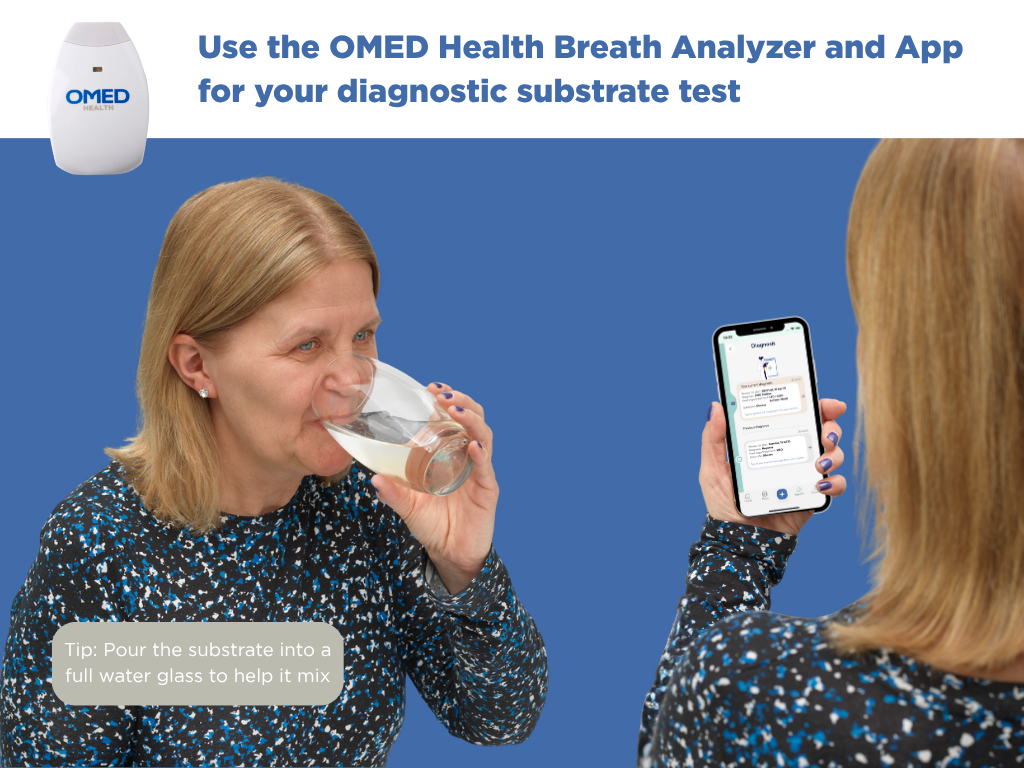Home Testing for SIBO and IMO
The OMED Health Breath Analyzer is the only handheld medical device able to aid in the diagnosis of common gut conditions including SIBO (small intestinal bacterial overgrowth) and IMO (intestinal methanogen overgrowth). These conditions are characterized by a range of gut symptoms including bloating, diarrhea, constipation, excess gas, tiredness, and nausea.
What’s the difference between lactulose and glucose tests?
As explained in the video below, the body reacts to each of these substrates differently.
Lactulose is a synthetic sugar that cannot be absorbed by the body. This means that it will travel through all regions of the small intestine without being absorbed. If there is bacterial overgrowth present, the sugar will be fermented by organisms in the gut into hydrogen gas. Readings over a certain threshold in a specific timeframe indicate SIBO. However, if it passes through the gut too quickly, you may receive a false positive result. This is because lactulose may reach the large intestine faster, where it can be fermented by the bacteria typically found there. The resulting hydrogen gas readings could therefore appear soon after ingestion, mimicking SIBO even if there isn’t a bacterial overgrowth in the small intestine.
Glucose, on the other hand, is a sugar that can be absorbed by the small intestine. This means that it could be absorbed before reaching a bacterial overgrowth present in the latter half of the small intestine. This increases the likelihood of a false negative result. The glucose test can be used for people with altered gut anatomy – for example, people who have had weight loss surgery, as it reduces the risk of false positive results that could result from these surgeries, when using lactulose.
If you would like advice on which to choose, it is best to consult with your OMED Health doctor as some people may have a strong reaction to the lactulose substrate. Our FAQs page explains more.
How does the OMED Health Breath Analyzer work?
The OMED Health Breath Analyzer measures the levels of hydrogen and methane in your breath, which are gases produced by your gut microbiota. To complete a SIBO test, you will be guided by the OMED Health App, including how to prepare for the test. Your readings will be reviewed by an OMED Health Doctor before you receive your test results via the app. You can download it for free to start tracking your diet, lifestyle and symptoms.
How much does the SIBO test cost?
If you would like a long-term monitoring solution to your symptoms, you can choose OMED Health Plans. Buy your OMED Health Breath Analyzer to get started at a cost of £249. This includes checking for IMO as part of the baseline plan. If you receive a negative diagnosis, an OMED Health Doctor will likely advise you to purchase a SIBO test for an additional £49. Depending on your results, an OMED Health Doctor will recommend your best next steps.

Purchasing an OMED Health Breath Analyzer allows you to monitor your own levels of breath hydrogen and methane which show up immediately after taking a sample. Download the app to log food, mood, stool quality, and a variety of gut symptoms. You can also use the app to book yourself in for a one-to-one 45-minute video consultation with an OMED Health Doctor. Rely on expert support to effectively manage your symptoms over time and correlate changes in diet or stress with your gut microbiome.




